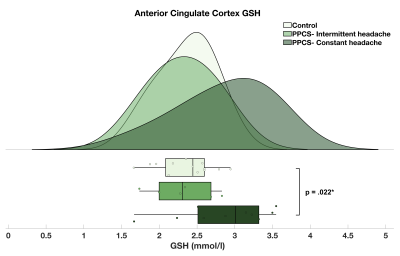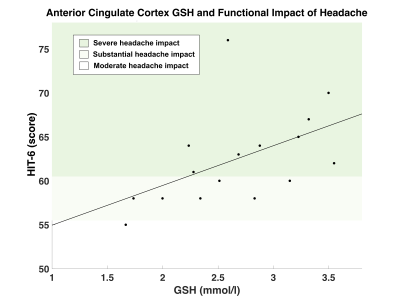Julie M Joyce1,2,3,4, Leah J Mercier2,4,5, Parker L La1,2,3,4, Tiffany Bell1,2,3, Julia M Batycky2,4,5, Chantel T Debert2,3,4,5, and Ashley D Harris1,2,3,4
1Department of Radiology, University of Calgary, Calgary, AB, Canada, 2Hotchkiss Brain Institute, University of Calgary, Calgary, AB, Canada, 3Alberta Children's Hospital Research Institute, University of Calgary, Calgary, AB, Canada, 4Integrated Concussion Research Program, University of Calgary, Calgary, AB, Canada, 5Department of Clinical Neurosciences, University of Calgary, Calgary, AB, Canada
1Department of Radiology, University of Calgary, Calgary, AB, Canada, 2Hotchkiss Brain Institute, University of Calgary, Calgary, AB, Canada, 3Alberta Children's Hospital Research Institute, University of Calgary, Calgary, AB, Canada, 4Integrated Concussion Research Program, University of Calgary, Calgary, AB, Canada, 5Department of Clinical Neurosciences, University of Calgary, Calgary, AB, Canada
Using edited spectroscopy, we found increased glutathione in the anterior cingulate is associated with greater functional impact of headache in patients with persistent post-concussive symptoms suggesting oxidative stress is related to post-traumatic headache.

Figure 2. Raincloud plot depicting the GSH concentration distribution (mmol/l) in the anterior cingulate cortex of PPCS participants with intermittent (mean = 2.31 ± 0.41; n = 6) and constant headache (mean = 2.86 ± 0.61; n = 10) and matched, injury-free controls (mean = 2.36 ± 0.37; n = 13).

Figure 3. Association between functional impact of headache and GSH concentration (mmol/l) in the anterior cingulate cortex. GSH in the anterior cingulate cortex was positively correlated with HIT-6 scores; (higher HIT-6 scores indicates greater functional impact of headache) r(16) = 0.507, p = 0.045*. HIT-6 score classifications: (1) little-to-no impact (score: 36-39), (2) moderate impact (score: 50-55), (3) substantial impact (score: 56-59), (4) severe impact (score 60-78).
